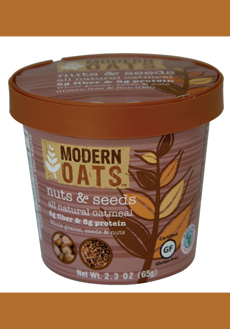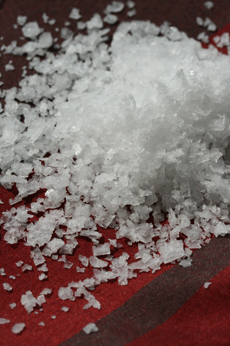
A better breakfast option than many, but still
high in sugar. Photo courtesy Modern Oats. |
|
Modern Oats is a packaging concept that puts oatmeal in a grab-and-go mode.
All you have to do is add hot water to cover the oats in the coated paper container, put the lid back on, wait 10 minutes and enjoy. No microwave is required, and the colorful packaging gives a boost to starting the day.
The rolled oats are grown by family farmers in the foothills of the Canadian Rocky Mountains. They are minimally processed by steaming and flaking; you look into the carton and see what looks like “real oats,” instead of the small particles familiar to consumers of instant oatmeal. The oat flakes provide a textural differences that deliver a more solid bite (and, the company says, optimal absorption of nutrients).
Modern Oats are produced in a 100% gluten free facility and are certified GF, Non-GMO, Halal, Kosher, Vegan and 100% Whole Grain. (Whew: There’s no more room left on the carton for any more certifications).
Oats are naturally gluten free*, and are the only major grain proven to help blood cholesterol†.
|
A MODERN BREAKFAST OPTION
The containers were initially intended to be sold in coffee shops and other convenience locations, for a suggested retail of of $3.25 per cup. The brand’s parent company, Innovative Beverage Concepts Inc., develops products for cafés.
While retail prices vary widely, we were surprised at the cost to buy them online:
On Amazon.com, a 12-pack is $44.00, or $3.67 per unit; in (individual flavors or a variety pack.
You can buy six-packs on the Modern Oats website for $21.00, or $3.50 per unit.
Depending on how much you typically spend on breakfast, it could be a wash, a bargain or a convenience premium that’s worth it for the fiber grain infusion (one serving delivers 28% of the recommended Daily Value of whole grains).
Or, you could cook up a weekly batch of steel-cut oats every Sunday, bring the portion to work and heat in the office microwave. If you enjoy your oats without sugar or with a noncaloric sweetener, you can also save the not-insignificant sugar calories in the various flavors:
Apple Walnut: 310 calories, 17g sugar
Chocolate Cherry: 310 calories, 20 g sugar, 9g protein, 7g fiber
5 Berry: 250 calories, 46g sugar, 9g protein, 7g fiber
Goji Blueberry: 310 calories, 18g sugar, 9g protein, 8g fiber
Mango Blackberry: 300 calories, 20g sugar, 9g protein, 7g fiber
Nuts & Seeds: 280 calories, 14g sugar, 8g protein, 6g fiber
But, there’s just as much—if not more—sugar in many of the foods we pick up for breakfast. Interestingly, a Pop Tart, though empty calories, has fewer calories and the same amount of sugar.
And if you think you’re not getting sugar in that bagel and cream cheese, check again. According to Self nutrition data, a small plain bagel, half to one-third the size of today’s supersized bagels, has 6g of sugar.
Is a cup of Modern Oats better than grabbing a bagel or a pastry? Absolutely!
*In the milling and processing process, oats are susceptible to cross-contamination; so that not all oatmeal and other oat products are gluten free. /font>
†Eating three grams of soluble fiber from oats each day, as part of a diet that’s low in fat and cholesterol, has been shown to lower blood cholesterol. This may reduce the risk of heart disease.
|






